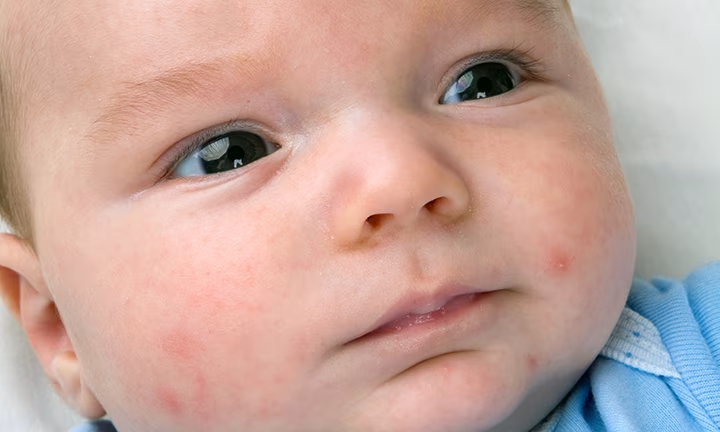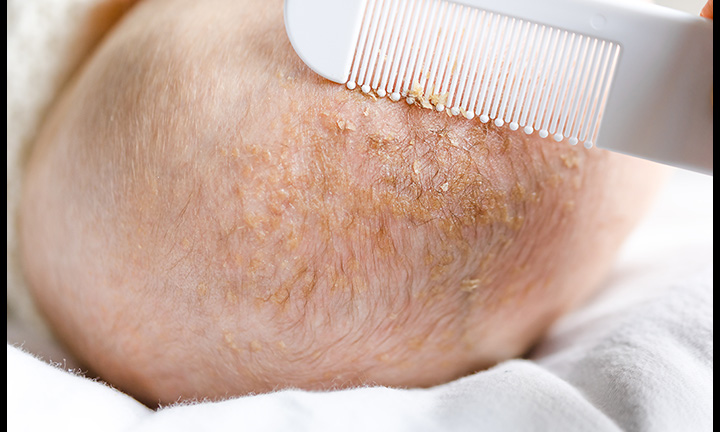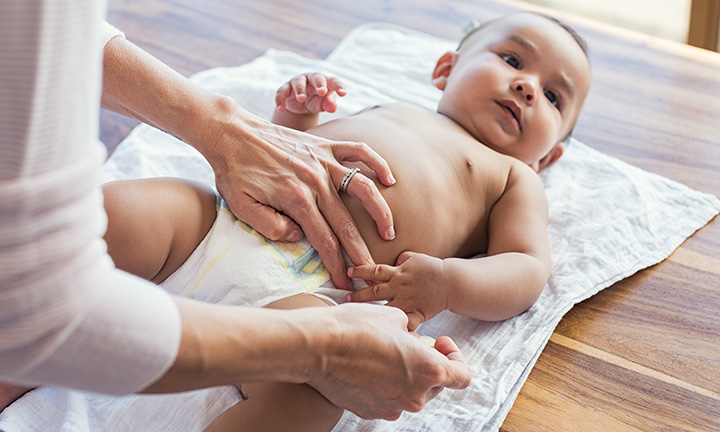
Baby & Newborn Acne: Causes and Treatment
Key Takeaways
As you spend time looking at your newborn, getting to know every little detail, don’t be surprised if you start to see pimple-like spots on your baby’s face during the first few weeks. These red spots might be baby acne – a common condition in newborn infants. Learn more about what causes acne on your newborn baby’s face, how long baby acne typically lasts and how to help and care for your baby's delicate skin.
What Is Baby Acne and What Causes It?
In the first few weeks after your newborn baby is born, you may start to see small pimples on their face, usually on the cheeks, nose and/or forehead.
Although only your baby’s doctor can make a diagnosis after seeing your baby, it is probably baby acne – also known as newborn acne or neonatal acne. Baby acne is a common and harmless skin condition that happens when hair follicles become blocked, leading to a build-up of the natural oils secreted by your baby’s skin.
What Does Baby Acne Look Like?
Baby acne looks like tiny red or white spots, which may be surrounded by red skin. Baby acne often appears as pimples on your infant's face, especially the cheeks, nose and/or forehead.
Although it may look like the acne that teenagers and adults can experience, baby acne does not lead to blackheads or whiteheads.
Other Types of Rash You Might Mistake for Baby Acne
Baby acne isn’t the only possible cause of red spots or blotches on your newborn’s skin. Here are a couple of other common baby rashes that might be easy to mistake for baby acne:
Your midwife, health visitor or doctor will be able to tell you what’s behind those little red spots, if you’re wondering what the underlying cause may be.
How Long Does Baby Acne Last?
Baby acne may first appear on your newborn within a month after birth. So, when does baby acne go away? It's a temporary condition that typically clears up after a few weeks or months.
Baby Acne Treatment: How to Get Rid of Baby Acne
If you’re wondering how to treat and clear baby acne, there’s actually no treatment, but don’t worry – as we mentioned above, it usually clears up by itself within a few weeks or months, leaving no scars.
Here are some gentle ways to care for your baby’s skin and help the baby acne to clear up:
You could wash your baby’s face while giving your baby a bath. If you don’t feel confident about bathing your newborn yet – or on days when your infant doesn’t have a ‘proper’ bath – it’s fine to just clean your baby’s face and nappy area. This is sometimes known as ‘topping and tailing’.
’Topping and Tailing’ Your Baby Who Has Neonatal Acne
Here’s a quick guide to cleaning your baby’s face and nappy area:
1) Undress your baby except for a vest and nappy and wrap him or her in a towel. 2) Hold your baby facing you in your lap or place him or her on a changing mat. 3) Start with the eyelids: Wipe the eyelids with cotton wool that’s been dipped into a bowl of lukewarm water. Use a fresh piece of cotton wool for each eye, and wipe from the nose outwards – don’t use soap for the eye area. Also avoid using soap on any areas of dry skin or eczema. 4) Do the same with the other parts of the face, neck, hands and around (but not inside) the ears, using a new piece of cotton wool for each area. You can use a mild soap as well as the water to gently cleanse the parts of the face affected by baby acne. 5) Remove the nappy and wash the nappy area with some fresh cotton wool and lukewarm water. 6) Dry your baby carefully (making sure to dry all the folds of the skin) and put on a clean nappy.
A ‘top and tail’ bath is an easy way to help make sure your baby’s skin stays clean and protected. For more tips, check out these 6 steps on how to sponge bathe a newborn
When Should You See a Doctor?
If your baby seems out of sorts or has other symptoms like a high temperature besides the spots, or if you're concerned that the condition isn't getting better after several weeks, let your health visitor or doctor know.
If your baby develops pimples or blackheads after three months of age, it may be a different condition known as infantile acne.
Infantile acne can be more severe than baby acne, so ask your doctor or a pharmacist for advice on how best to treat it.
Go to the A&E or call 999 if your baby has a rash that doesn’t fade when you push a glass against it. This can be a sign of meningitis, which needs urgent treatment. Other warning signs of meningitis that should not be ignored include:
FAQS AT A GLANCE
While there’s no direct link between breastfeeding and baby acne, breastmilk does have plenty of benefits including, reducing your baby’s risk of infections, as well as containing anti-inflammatories.
The Bottom Line
A little baby acne won’t make your newborn any less adorable. Just like teenage acne, neonatal acne is just something that can happen as a part of growing up.
Take care of your little one's skin as best as you can, wait for it to pass and keep giving those little cheeks plenty of kisses.
How We Wrote This Article The information in this article is based on the expert advice found in trusted medical and government sources, such as the National Health Service (NHS). You can find a full list of sources used for this article below. The content on this page should not replace professional medical advice. Always consult medical professionals for full diagnosis and treatment.
Read more about Newborn Baby
Related Articles
Join Pampers Club and get:













